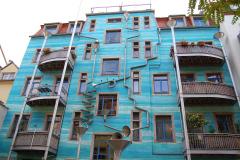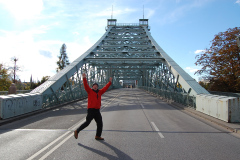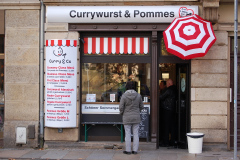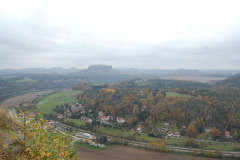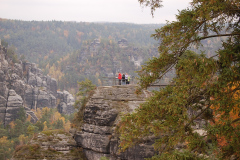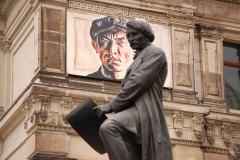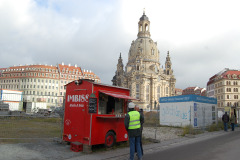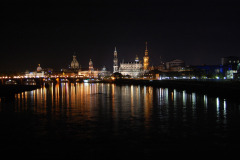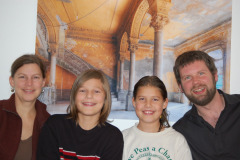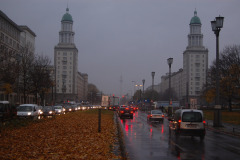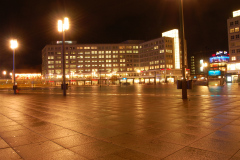Brief trip with the family to Dresden and Berlin in 2010.
Dresden is a surprisingly large, lively, and pretty city. It helps, though, as always, to have a local show you more than just the old buildings in the center (thanks, Dirk!!!). The West Germans have done a good job of unifying the country, because at least in the central part of Dresden there’s not much to remind a visitor that this city used to be deep in the farthest reaches of East Germany. Comfy taverns, perfectly manicured bicycle lanes, recycling bins, vegetable gardens on the outskirts of town…I guess Germany is Germany is Germany, no matter what direction you’re looking in.
A few tips:
Die Koje — A hostel run by a “social project” on a boat moored on the Elbe. The walls are thin (bad when there’s a group of students on a field trip), bathrooms are down the long hallway, and tall people beware the low ceilings and short beds. But the breakfasts are good, the location convenient, and every once in a while you can feel the boat gently shift on the water.
Nepple Eis — Not really a cafe, since Nepple’s main business deals in bigger ice cream orders. But all the neighbors know that they can pop in whenever they like to satisfy a craving with one (or all three) of the daily flavors on offer: different every day, whatever the owner has been experimenting with, but all delicious.
Cafe-Restaurant Luisenhof in hoity-toity Weißer Hirsch, where the rich people go for Sunday lunch. And also normal people for coffee and cake and a view Dresden from above. The Apfelschmandkuchen is very good.
Riesa — a small tavern/restaurant behind Bahnhof Mitte in Dresden (Adlergasse 14). Very unassuming but cool, with blocky wooden tables and a student clientele. Simple, tasty food. Get there early, because it fills up.
On to Berlin… It’s a big city. Easy to feel at home in, but a bit overwhelming as a tourist destination. It’s got the requisite huge Neo-Classical government and cultural buildings, the Soviet apartment blocks, the fancy shopping street, the museums, the clubs, the restaurants. And oh yes, it’s also got the Wall. Berlin plays up the Wall at every chance; there’s no way of escaping it.
I remember giving up my passport in 1985 to stern border guards at Checkpoint Charlie in order to get into East Berlin for a couple of hours — my first in-person experience with the Eastern Bloc. The next time I was there, the Wall had just come down a few months earlier and we still hesitated when we saw the guards, but they just turned away, bored, as we climbed through a hole in the Wall and crossed to the other side. This time, all that’s left is a cobbled path through the city and Prenzlauer Berg has become yuppie heaven (particularly Kollwitzstraße).
For us, the Wall hype and Holocaust memorials are plenty interesting. But the little bronze cobblestones in the sidewalks commemorating deported Jews in front of their former houses hit just as close.
For all the money and architectural clout dumped onto Potsdamer Platz (in my memory just a huge empty lot), Alexanderplatz is still more alive and “works” much better on a human scale. The architecture there is atrocious, but that’s part of the charm. Between the Neo-Classical, Soviet, and modern architecture (lots of which is quite impressive), Berlin looks a lot like the non-Medieval parts of most other German cities: practical but not particularly pretty.
Berlin is, however, very reasonably priced for its size, especially the food. Remember Friedrichshain when you’re looking for someplace to eat. Prenzlauer Berg is also good for the stomach. We rented a holiday apartment through MOWITANIA and were very pleased with it. It doesn’t even matter a whole lot what part of the city you stay in, because the public transportation system is very good (buy an unlimited travel pass, however, because individual fares add up). Like they say, Berlin is very large and spread-out and lacks a true city center. In our opinion, though, Alexanderplatz has become the de facto center.
The Sunday flea market in Mauerpark is huge. Don’t get lost.
Modeinstitut (Samariterstraße 8 ) and Anziehend (Niederbarnimstraße 16) in Friedrichshain are two nice second-hand stores.
The Neue Nationalgallerie — mostly German art from the first half of the 20th century. Big and good.
Brücke Museum — very nice and elegant, but be forewarned that it’s tiny. Take your time and savor each painting to make the EUR 5 entrance fee worth it. It’s a ways out, in the pretty, well-to-do suburb of Dahlem.
Other highlights were fresh Brötchen for breakfast every day of the week, cheap tasty Thai take-out, and Turkish kebaps and felafel and baklava. Also the good luck we had with waitresses and waiters in both Dresden and Berlin — quite the characters.
And remember: wherever you are in Germany, watch out for those bicycles. The riders are mean if you step into their lane.
